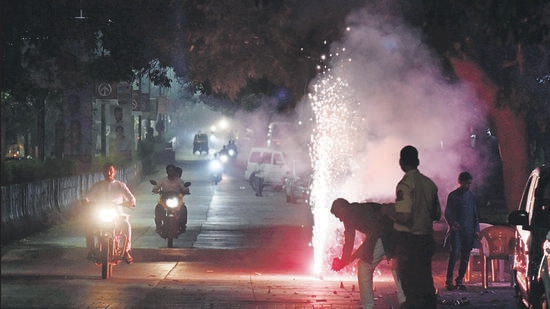Best air quality in Pune since 2019 this Diwali, despite cracker bursts
Despite the bursting of firecrackers at several locations, the city recorded ‘satisfactory’ AQI with Pm10 at 74 micrograms per cubic metre (g/m3) and Pm2.5 at 45 g/m3. In 2019 when the average Pm2.5 level was the lowest in the past decade, the concentration on Diwali day was 37.7 g/m3
The city has reported ‘satisfactory’ air quality index (AQI) this Diwali, which is the best since 2019, according to the Indian Institute of Tropical Meteorology’s (IITM’s) System of Air Quality and Weather Forecasting and Research (SAFAR). At 9 pm on Laxmi puja day on Monday, Pune recorded ‘satisfactory’ AQI post the firecracker-bursting period.

Despite the bursting of firecrackers at several locations, the city recorded ‘satisfactory’ AQI with Pm10 at 74 micrograms per cubic metre (g/m3) and Pm2.5 at 45 g/m3. In 2019 when the average Pm2.5 level was the lowest in the past decade, the concentration on Diwali day was 37.7 g/m3. Whereas the maximum permissible limit for this pollutant is 60 g/m3.
B S Murthy, project director, IITM-SAFAR, said, “Pune recorded ‘satisfactory’ AQI as the pollution level was under control due to low daytime temperature and less accumulation owing to stable inversion layer. This is because of the rain in the past few days which led to improvement in air quality. Tomorrow, the air quality might go down to moderate.”
The AQI - which is classified into six categories, including good + satisfactory, moderately polluted, poor, very poor, and severe – transforms the complex air quality data of various pollutants into a single number (index value).
The real-time pollution data by SAFAR showed that the average Pm10 (atmospheric particulate matter that has a diameter of less than 10 micrometre) in Pune was 95 μg/m3 and the Pm2.5 (atmospheric particulate matter that has a diameter of less than 2.5 micrometre) was 60 μg/m3. According to SAFAR, AQI in the 0-50 range is considered good; 51-100 satisfactory; 101-200 moderate; 201-300 poor; 301-400 very poor; and anything above 400 severe. Earlier in the day, the Pm10 was recorded at 81 g/m3 while Pm2 was recorded at 48 g/m3 mostly due to vehicle pollution. Interestingly the Maharashtra Pollution Control Board (PMCB) had recently banned firecrackers causing high pollution, which has resulted in less air pollution. Although an MPCB official also said, “Prima facie, an increase in noise level by 10% was observed at the Shaniwar wada location and at Shivaji nagar during the day.”
Noise monitoring was carried out on October 21 before Diwali and October 24 during Diwali at Karve road (Nal stop), Satara road (City Pride), Swargate, Yerawada (mental hospital/jail road), Khadki (Khadki bazar), Shaniwar wada, Laxmi road, Saras baug, Aundh gaon, and University chowk. Noise monitoring will also be carried out on October 26.





